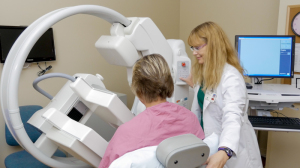
A patient is positioned for a molecular
breast imaging exam using Gamma
Medica's LumaGEM system
From the July 2017 issue of HealthCare Business News magazine
By Philip Croxford
As the patient demand for more personalized care increases and mammography is recognized as no longer the one-size-fits-all solution for breast imaging, many providers find themselves weighing the options regarding secondary breast imaging modalities.
To make an informed decision, there are four important questions a provider must consider: whether they’re thinking specifically about their patients with dense breast tissue; if they’ve done enough to screen for breast cancer; have they provided adequate assurance that cancer is diagnosed; and if they have chosen the most preferred modality for the patient.
Question 1: Are your patients with dense breast tissue treated at your facility receiving adequate care?
In the U.S., approximately 50 percent of women are reported to have dense breast tissue and are unaware of the implications dense breast tissue has on increasing their lifetime risk of breast cancer.
It’s important for providers to diagnose their patients’ breast density and recommend the appropriate primary and secondary screening requirements. Dense breast tissue and cancer both appear white on mammograms (both 2-D and 3-D/tomosynthesis), making it difficult to distinguish between the two. Trying to find a cancerous lesion in dense breast tissue on a mammogram is like trying to find a snowflake in a snowstorm. Not properly identifying the cancer can, in turn, lead to both false positives (overdiagnosis) and false negatives (missed diagnosis), ultimately resulting in delayed diagnoses. It’s no secret that early diagnosis is critical to improving the odds of successfully combating the disease. Providing a secondary screening protocol for women with dense breast tissue is essential to be certain that nothing has been missed.
Question 2: Pre-Cancer Screenings: Do your patients leave their breast cancer screening confident that nothing has been missed?
Facilities should offer patients with dense breast tissue secondary screenings to ensure cancerous lesions hidden by dense tissue are not going undiagnosed. While more than half of U.S. women have dense breast tissue, for some subgroups that percentage is higher. For example, 65 to 70 percent of women of Asian descent have dense breasts. Without accounting for breast density, mammography screenings can be largely ineffective for this patient group. In certain circumstances, more sensitive modalities can be used for secondary screening, such as in high-risk and dense breast tissue patients. One such modality is molecular breast imaging (MBI) that has been proven to deliver high sensitivity and even higher specificity than 3-D mammography (tomosynthesis), ultrasound and even MRI. The modality has a convenient user protocol, and it’s safe and efficient in terms of procedural and read time.
